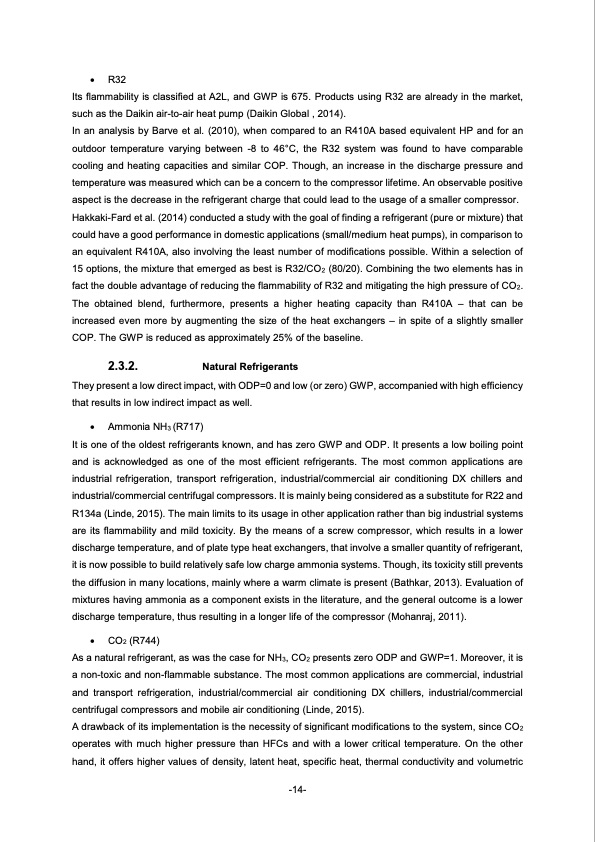
PDF Publication Title:
Text from PDF Page: 023
R32 Its flammability is classified at A2L, and GWP is 675. Products using R32 are already in the market, such as the Daikin air-to-air heat pump (Daikin Global , 2014). In an analysis by Barve et al. (2010), when compared to an R410A based equivalent HP and for an outdoor temperature varying between -8 to 46°C, the R32 system was found to have comparable cooling and heating capacities and similar COP. Though, an increase in the discharge pressure and temperature was measured which can be a concern to the compressor lifetime. An observable positive aspect is the decrease in the refrigerant charge that could lead to the usage of a smaller compressor. Hakkaki-Fard et al. (2014) conducted a study with the goal of finding a refrigerant (pure or mixture) that could have a good performance in domestic applications (small/medium heat pumps), in comparison to an equivalent R410A, also involving the least number of modifications possible. Within a selection of 15 options, the mixture that emerged as best is R32/CO2 (80/20). Combining the two elements has in fact the double advantage of reducing the flammability of R32 and mitigating the high pressure of CO2. The obtained blend, furthermore, presents a higher heating capacity than R410A – that can be increased even more by augmenting the size of the heat exchangers – in spite of a slightly smaller COP. The GWP is reduced as approximately 25% of the baseline. 2.3.2. Natural Refrigerants They present a low direct impact, with ODP=0 and low (or zero) GWP, accompanied with high efficiency that results in low indirect impact as well. Ammonia NH3 (R717) It is one of the oldest refrigerants known, and has zero GWP and ODP. It presents a low boiling point and is acknowledged as one of the most efficient refrigerants. The most common applications are industrial refrigeration, transport refrigeration, industrial/commercial air conditioning DX chillers and industrial/commercial centrifugal compressors. It is mainly being considered as a substitute for R22 and R134a (Linde, 2015). The main limits to its usage in other application rather than big industrial systems are its flammability and mild toxicity. By the means of a screw compressor, which results in a lower discharge temperature, and of plate type heat exchangers, that involve a smaller quantity of refrigerant, it is now possible to build relatively safe low charge ammonia systems. Though, its toxicity still prevents the diffusion in many locations, mainly where a warm climate is present (Bathkar, 2013). Evaluation of mixtures having ammonia as a component exists in the literature, and the general outcome is a lower discharge temperature, thus resulting in a longer life of the compressor (Mohanraj, 2011). CO2 (R744) As a natural refrigerant, as was the case for NH3, CO2 presents zero ODP and GWP=1. Moreover, it is a non-toxic and non-flammable substance. The most common applications are commercial, industrial and transport refrigeration, industrial/commercial air conditioning DX chillers, industrial/commercial centrifugal compressors and mobile air conditioning (Linde, 2015). A drawback of its implementation is the necessity of significant modifications to the system, since CO2 operates with much higher pressure than HFCs and with a lower critical temperature. On the other hand, it offers higher values of density, latent heat, specific heat, thermal conductivity and volumetric -14-PDF Image | Next generation of refrigerants for residential heat pump systems

PDF Search Title:
Next generation of refrigerants for residential heat pump systemsOriginal File Name Searched:
MartinaLonghini_ThesisReport.pdfDIY PDF Search: Google It | Yahoo | Bing
CO2 Organic Rankine Cycle Experimenter Platform The supercritical CO2 phase change system is both a heat pump and organic rankine cycle which can be used for those purposes and as a supercritical extractor for advanced subcritical and supercritical extraction technology. Uses include producing nanoparticles, precious metal CO2 extraction, lithium battery recycling, and other applications... More Info
Heat Pumps CO2 ORC Heat Pump System Platform More Info
| CONTACT TEL: 608-238-6001 Email: greg@infinityturbine.com | RSS | AMP |